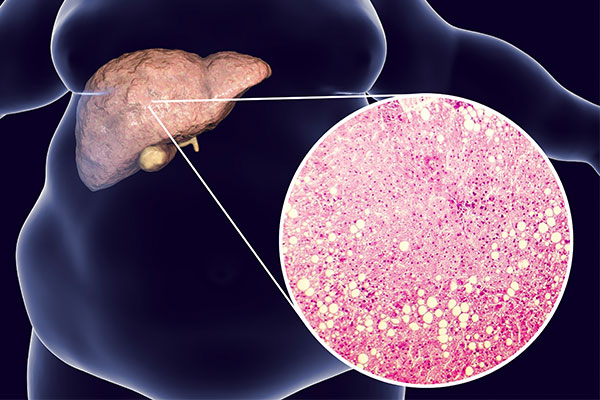Fatty liver disease

Fatty liver disease is a condition where excess fat builds up in the liver. There are two main types of the disease, non-alcoholic fatty liver disease and alcoholic liver disease.
Non-alcoholic fatty liver disease (NAFLD) refers to a spectrum of liver disorders ranging from accumulation of too much fat inside liver cells to fibrosis, cirrhosis, liver failure or liver cancer that is not due to alcohol consumption or other secondary causes. It is pervasive in Hong Kong, with a prevalence of 27.3% and annual incidence of 3.4% among Chinese adults.
Alcoholic liver disease is caused by alcohol overconsumption that leads to alcoholic hepatitis, and chronic hepatitis with liver fibrosis or cirrhosis.
Symptoms
Fatty liver is often asymptomatic. When it exhibits symptoms, they are generally nonspecific, such as loss of appetite, nausea and vomiting, right upper quadrant discomfort and fatigue.
Fatty liver can develop into a fibrosis, cirrhosis, or even a liver cancer. Patients with cirrhosis may have abdominal swelling, enlarged blood vessels just beneath the skin's surface, jaundice, and enlarged spleen.
Causes and risk factors
Development of fatty liver is strongly associated with overconsumption of alcohol, obesity, insulin resistance, diabetes, dyslipidaemia and hypertension and is regarded as the liver manifestation of metabolic syndrome.
A medical study reported that the risk for fatty liver was roughly 20-fold higher in people with obesity, 18-fold higher in people who abuse alcohol, 3.5-fold higher in people with type 2 diabetes, 3-fold higher in people with elevated serum triglyceride, 84% higher in people with elevated serum low density lipoprotein cholesterol, and 50% higher in people with elevated fasting plasma glucose.
Diagnosis
For most cases, fatty liver disease is discovered incidentally by routine physical checks with blood tests showing abnormalities of the liver functions. If citizens suspect fatty liver, they should seek medical advice and may need further investigations including Fibroscan and ultrasound scan of liver.
Treatment
Treatment for fatty liver depends on the cause and severity of the condition. For patients with co-existing obesity, type 2 diabetes or hyperlipidaemia, making changes towards a healthier lifestyle are the primary recommendations. That includes eating a healthy diet and regular exercise to achieve gradual and sustained weight loss.
For patients with alcohol-related fatty liver, they should stop drinking alcohol immediately that it may reverse fatty liver changes.
Medications would sometimes be required to control the underlying medical diseases and complications. For fatty liver patients with progression to end-stage liver disease, liver transplantation may be required.
Prevention
Non-alcoholic fatty liver disease is largely preventable and reversible if caught early in its development. Living a healthy lifestyle can play a big role in preventing and controlling the disease. For healthy people, experts recommend a balanced diet for maintaining a healthy weight, but avoid high fat food. Regular health check-up can help find liver problems before they start. Besides, doing exercises can help mental and physical stress.
*The above information is for reference only, please consult your doctor for detail.

 3405 8288
3405 8288
